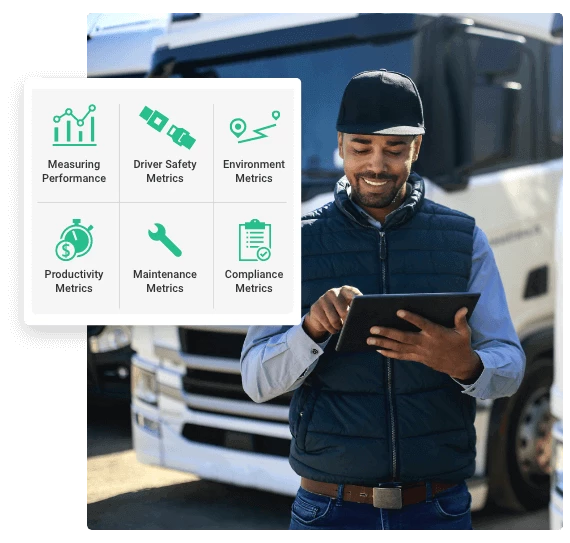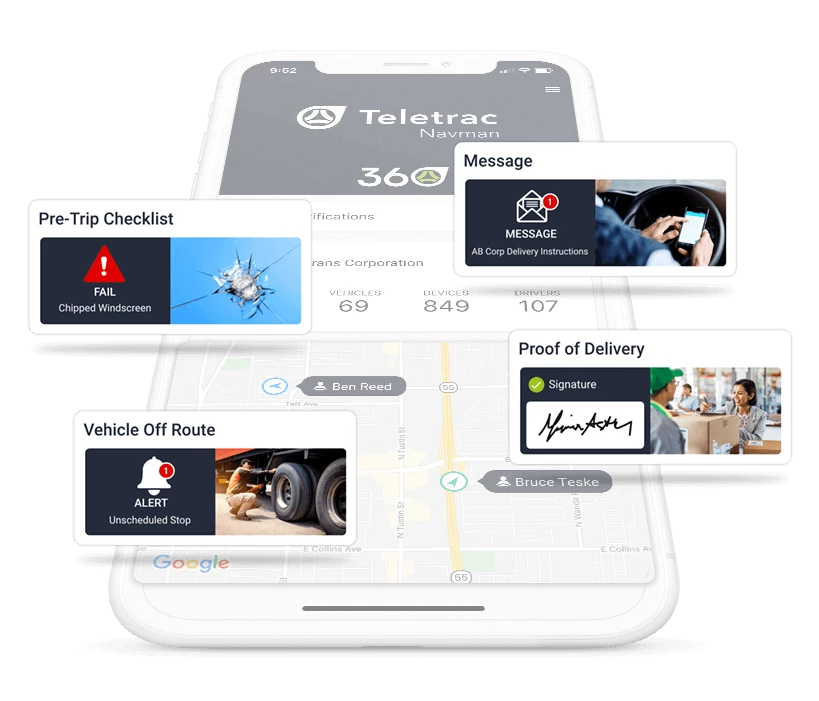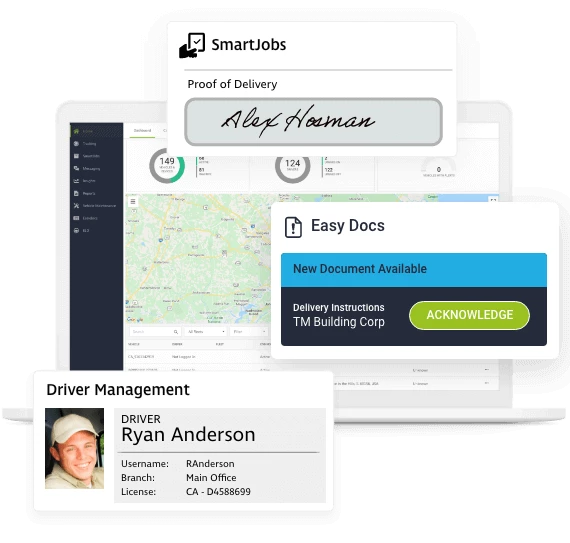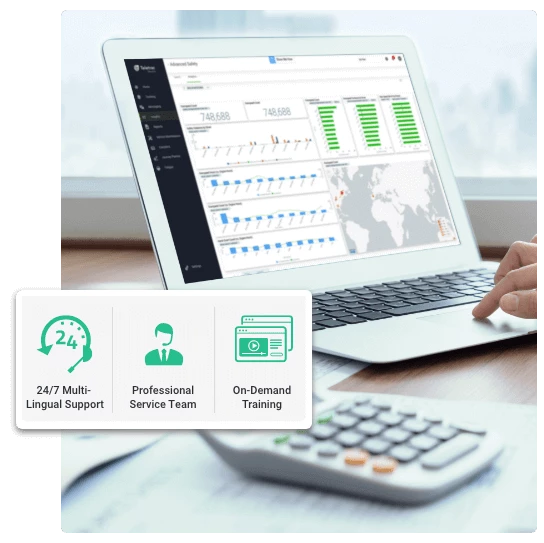Key Takeaways
Moving to a new fleet management system is a big decision. Find out what features your company should look out for, what questions to ask prospective partners, as well as what you should expect during the onboarding process.
Table of Contents
- When is it time to shop for new fleet management software?
- How to find the right fleet management solution
- Making the switch to a fleet management software provider
When is it time to shop for new fleet management software?
Switching to a different partner is a big decision for any company, and the importance and complexity of this decision only deepens the longer the partnership has been around. Technical limitations, a lack of product support, and even a rocky onboarding can cause companies to look for other partners. For many companies, the choice to leave their current partnership comes down to a combination of reasons, the most common of which we've outlined below.
Limitations Measuring Fleet & Driver Performance
Measuring performance is a crucial feature of any fleet management system. If you are unable to answer questions about the efficiency, safety or productivity of your fleet, it may be time to look for a different partner who provides more in-depth data about your fleet. Here are some specific performance metrics to look for to increase visibility over your operation.
Driver Safety Metrics - This can be the speed a vehicle is moving at, its acceleration, harsh braking, and other potentially dangerous behaviors. Additionally, the fleet management system can monitor distracted driving through a combination of cameras and intelligent software integration. Distracted driving is anything that takes the driver's eyes off the road while moving, such as texting and driving.
Environmental Metrics - Environmental metrics provide fleet managers with the data needed to optimize routes and driver behavior to reduce environmental impact. The metrics include information like how long vehicles are idling, whether vehicles are taking the shortest routes, monitoring each vehicle's CO2 emissions, and even tracking aggressive driving behaviors which increase fuel burn.
Productivity Metrics - This can be data about how long each job should take, how fast teams arrive at job sites and how long the driver is waiting on site. These metrics help define where productivity is lost. For example, one driver being delayed by 20 minutes at a delivery location once a week is manageable, but if you have 50 drivers you are losing nearly 17 hours of time. Understanding if this is happening, and where, can help you remove a significant amounts of waste from your schedule.
Maintenance Metrics - Regular fleet maintenance enables companies to maximize vehicle uptime and minimize unscheduled downtime. Digital maintenance tools can track which vehicles should go in for maintenance based on odometer readings, create maintenance schedules and track maintenance costs. Remember, there is a big difference in anticipating a cost versus receiving an unexpected one.
Compliance Metrics - All companies should aim to have zero HOS (Hours of Service) violations. HOS tools provide the drivers with clear instructions about when they need to take a break, and operators with information to plan work schedules without putting drivers at risk of a violation. Other areas of compliance that your business might need include Driver Vehicle Inspection Reports (DVIR) and IFTA reporting. Both can be digitally managed by the latest fleet management software.

Software Scalability
Admittedly, outgrowing your current solution is a good problem for your company to have. It means that your business has grown so much that your existing fleet management software solution no longer works for you. If businesses outgrow the capabilities of their existing provider, they need to seek a partnership with a new provider as soon as possible. It is important to find a partner that can meet your current challenges and also offers a wide range of solutions that can meet future needs. An example of this would be a software provider that offers a broad range of workflow tools. Your organization may not require a function today, but it might find the capability valuable as it expands. Having a wide range of flexible workflow tools allows your company to grow its software into new areas as needed.

Technical Capabilities
Another issue companies run into is technical limitations. Technical limitations may indicate it's time to switch providers, primarily if they cannot provide your organization with essential features. These features can include real-time fleet visibility, maintenance monitoring, driver safety, compliance modules, and workflow tools. These essential features are important in keeping your fleet agile, efficient, and cost-effective. Having a platform with a robust feature set and capabilities reduces the need to rely on third party integrations between multiple software providers. To better understand the features to look for, we've created a list below:
Real-time fleet visibility - This enables real-time location monitoring for equipment and vehicle tracking. Using real-time fleet management can help improve team performance by ensuring that location, status and availability information is always accessible so they can quickly take action to keep your operation moving.
Maintenance monitoring - This feature allows companies to see which vehicles are due for maintenance to prevent surprise repair costs and protect against costly unplanned vehicle downtime and delays to projects. Incorporating digital pre-trip inspections also streamlines fault detection and resolution.
Workflow tools - These are apps that connect drivers with the back office that provide streamlined processes for data capture and transfer. These apps can be used to digitally transform your business and include two-way messaging, custom forms, job dispatch with proof of delivery, live routing and document management. All of these tools should be part of the fleet management platform, so you don’t need to rely on software integrations.
Safety features - An increased focus on safety is often a reason companies switch partners. Fleet management software can offer an extensive array of safety features and have the ability to record dangerous driving events and provide fleet managers with the tools to reduce risk. These include driver safety scorecards that take a range of safety data points to calculate driver scores, enabling managers to train drivers and create incentive-based league tables. Fully integrated 360-degree cameras are also highly valuable safety tools, when powered by AI they provide additional visibility, enabling managers to monitor distracted driving, fatigued driving and tailgating. AI based cameras also have the ability to identify positive driving actions which can form part of a rewards program.
Compliance features - Compliance monitoring is a must in today's fleet management software. Implementing digital processes to manage compliance saves your company time and money by streamlining the administrative processes for local, state, and federal laws and regulations. There are multiple areas where fleet management software can improve compliance, such as ELD, DVIR, and IFTA. ELD solutions enable businesses to meet the rules set out in the ELD mandate, improve visibility into driver hours availability and reduce the risk of HOS violations. DVIR tools allow drivers to complete and submit daily pre-trip and post-trip inspections directly via their mobile device and ensure that vehicle faults are recorded and resolved quickly. And IFTA features simplify the process of filing IFTA fuel tax reports by automating the capture of miles traveled and gallons of fuel used in participating regions.
Driver compliance and safety applications - These in vehicle applications provide insight that will help drivers stay compliant with government regulations, reduce potential accidents, cut insurance costs and help to prevent costly litigation.

Product Support
The amount of product support a fleet management software company gives its partners is another common reason why companies look to transition to different providers. Smaller businesses offering fleet management solutions may struggle to provide adequate training support and supporting materials. It's important to remember that fleet management systems offer many services beyond location tracking. They provide compliance tools, safety features and business workflow applications that form a key part of business operations. Your team will require training on all aspects of the application and on-demand support when problems arise. When looking at alternative providers it is important that they can offer the support needed to help you fully utilize your solution.

How to find the right fleet management solution
Before you start searching for a new software provider, it's important to understand what exactly you are looking for in your new solution. When selecting a fleet management software partner, you'll want to ask them a series of questions to determine if they are the best fit for your business. These should be based around your requirements but we’ve compiled a list of questions to help get you started.
Questions to ask Fleet Management Software providers:
- How does your solution help maintain compliance for ELD/DVIR/IFTA?
- How does your system show driver / vehicle performance data?
- What data does your system gather to improve driver safety?
- What mobile applications are available on your platform?
- Can your solution integrate with a dashboard camera?
- How can your solution help me improve productivity?
- Does your software solution have the ability to track assets and on road vehicles?
- What integrations does your software offer, and is there an Open API?
- What is the fee structure for your service?
- Do you have onboarding support staff, and what are your ongoing support options?
- Do you offer in platform and on-demand training?
Making the switch to a fleet management software provider
After researching and choosing a partner that offers you the best solution for your needs, it's time to start the transition. During the transition to a new software platform, the software provider should work with you to set clear expectations around timelines, and be able to provide advice on how to successfully deploy the technology. A transition to a new fleet management system involves many variables and needs to be handled carefully. With that in mind, to best prepare for your transition to a new system, ask your provider these questions.
- How long do you expect our onboarding to take?
- What resources on my team will we need during the transition?
- When should I discontinue my contract with my existing fleet management software provider?
- When should we notify partners that we want to integrate with the new platform?
Decision Time
When considering if you want to switch partners, it is important to give yourself enough time to make a decision, which should ultimately be based on whether the value of the change will outweigh the cost of switching. Once you have made the decision that a change is needed it is key to choose a provider that will work with you to create and deploy a solution that will meet your objectives. A prolonged or troubled transition can cost your company time and money, and limit the success of the new technology being deployed.
That is why here at Teletrac Navman, we have a listen-first approach, so we can create a fleet management software solution that can help you achieve your goals. We also provide on-boarding support, access to live and on-demand training and 24/7 technical support. If you're interested in finding out more about Teletrac Navman and to discuss your solution, contact us at 1-(888)-799-4925 or build your custom solution using our online product builder. After configuring your solution, a representative will reach to schedule a discovery meeting.

